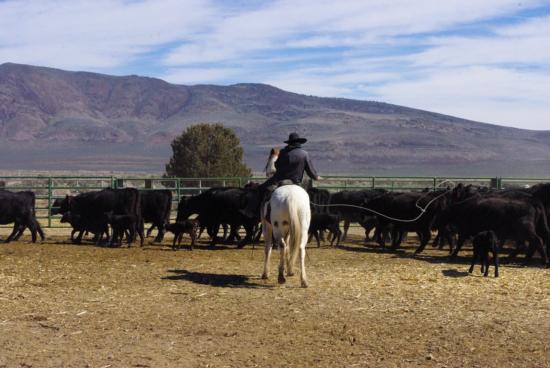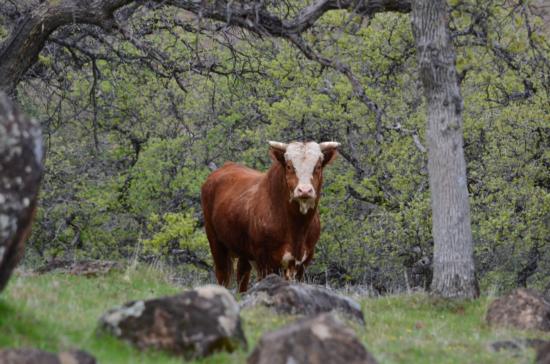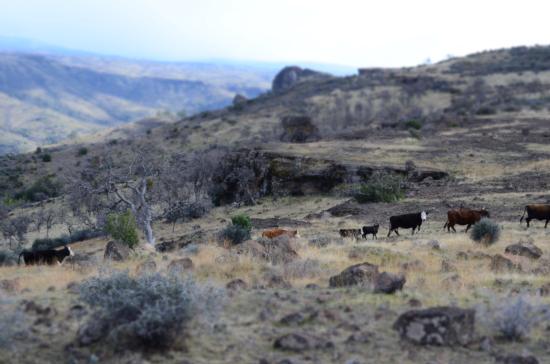Cattle Health and Husbandry
Publications
|
UCCE Advisors and Specialists write many papers summarizing research projects, monitoring procedures, and general management practices. All papers are peer-reviewed, meaning before they can be published, another set of people within the University review to ensure the papers are scientifically valid and not someone’s opinion. Here you will find free publications (available as a PDF) from the University of California, as well as links to larger publications you may purchase, each with a summary. In addition, each of the publications are available at your local UC Cooperative Extension office for your convenience. |
Beef Care Practices
Along with the basic information and practices for the care of beef cattle that were described in the earlier edition, this edition covers a number of new issues and opportunities including grass-fed beef and “natural” beef production, a national livestock identification program, and the growing use of prescribed grazing for vegetation management. In addition, the urbanization of California and the growing recognition that beef cattle can be effectively used as a resource management tool have brought to the forefront conflicts at the urban/rural interface, including nuisance problems and human-cattle-dog interactions. Click here for full text.
Bay Area Ranching Heritage
Livestock grazing has been practiced in California for more than 200 years, and it continues to benefit local communities today, not least by helping keep open space available for recreation use. Click here for full text.
Fundamentals of Beef Management
This handy guide was developed specifically for small-scale operations, and includes everything you need to know to get started in the beef cattle business. You'll find it helpful not only if you are new to the beef cattle business, but also if you have been away from the business for an extended time. http://anrcatalog.ucanr.edu/Details.aspx?itemNo=3495
Year in a life of a Cow
Extensive open space lands, owned and managed by public entities in California, are often managed with grazing livestock. Public land managers use grazing to manage vegetation for fire fuels, watershed protection, wildlife habitat and invasive species control. A well-managed livestock grazing program can be effective for vegetation management and at the same time compatible with public access and recreational activities. This publication goes right to the source to give you an idea of cattle’s place and role on public-access lands with an account of a year’s life, as related by one particularly eloquent beef cow. Click here for full text.
Beef Production in California
An older version of Fundamental of Beef Management, briefly covers same topics but does have very useful tables for beef cattle nutrition requirements and nutritional composition of common feeds. http://anrcatalog.ucanr.edu/Details.aspx?itemNo=21184
Caring for Cattle and Sheep
The care and feeding of livestock has a cyclic rhythm tied to the animals’ reproductive cycle and seasonal health needs. Ranchers must perform numerous tasks to keep their animals healthy and reproducing. This publication covers a variety of common tasks and their typical timing; referred to by ranchers as “working” cattle or sheep. A good herd health program is an essential part of a successful livestock business operation; and includes prevention and treatment of disease and, if disease occurs, preventing its spread. Click here for full text.
Cattle Management Strategies to Minimize Foothill Abortion
A tick-borne bacterial disease, commonly known as foothill abortion, kills cow fetuses and has had a devastating effect on herds grazing in parts of the intermountain West. This publication will help you develop management strategies that minimize the impacts of the disease including whether ticks are present in a pasture (identified by dry ice trapping), the time when ticks are active, and the stage of pregnancy of a heifer or cow when grazing pasture where ticks may be present. Click here for full text.
Cattle, Sheep, Goats, and Horses - what’s the difference
Part of the Understanding Working Rangelands series. Range livestock species differ in size, weight, behavior, and feeding preferences. Learn how these factors can influence their suitability for grazing on a particular area of multi-use rangeland. Click here for full text.
Raising your own Beef
A PDF of a 1979 publication, this basic publication still has relevant points for today. Topics discussed include selecting your calf, feed and water requirements and processing considerations. Click here for full text.

Balancing Cow Requirements with Season Forage Quality
Livestock on California's foothill rangelands get much of their nutrition from rangeland forage plants. The publication helps you strike the best balance of range forage to purchased feed in any given year. Click here for full text.
Pears - An Alternative Feed
Pears that are weather damaged or otherwise unsaleable need not go entirely to waste: you can still use them as feed for cattle, sheep, or goats. This brief publication gives you the basics on making the best of your fruit tree losses. While the focus is on cull pears, information is relevant for other fruits as well. Click here for full text.
Feeding Rice Straw
Rice straw is a by-product of the rice grain industry and is a potential low cost feed alternative for cattle. Rice straw has limited nutrients available to livestock and should only be a replacement part of the forage. This publication included keys to making rice straw work for you, challenges of feeding rice straw, and how to determine the nutritive content of rice straw. Click here for full text.
Crop Biotechnology- Feed for Livestock
Most crops developed through biotechnology that are on the market today provide farmers with increased convenience and product quality while requiring fewer chemical inputs.
Plant breeders are concentrating on enhancing grains or protein sources to produce feedstuffs that will improve feed utilization, performance, product quality, and health of livestock while reducing production costs and environmental impacts. It is likely that biotech crops of the future will play an important role in this arena. This publication discusses potential applications and safety issues associated with such products. Click here for full text.

Drought Strategies for Beef Cattle Culling
Removing animals from the herd is the most direct method of reducing forage consumption on drought-stricken rangeland. Strategic culling requires the ability to navigate the current year’s challenges while considering steps to rebuild for the future. Click here for full text.
Drought Tip: Supplemental Feeds for Cattle Operations
One of the advantages of cattle production in California is the diversity of feeds available. In most cases, supplementing with alfalfa hay is the easiest method to meet protein, energy, and calcium requirements when rangeland nutrients are depleted due to drought. When the market prices of these traditional hay supplements become high, it becomes necessary to consider alternative feed sources. This publication will help you make decisions for your cattle operation, depending on your budget and the nutrient needs of your cattle. Click here for full text.
Drought Tip: Drought Strategies for Feeding Cattle Grazing Annual Grassland
Drought leads to predictable lack of forage production on rangelands leaving two possible management scenarios: sell to reduce forage demand, or supplement feeding. This publication is designed to help producers weigh options available to prevent complete. Click here for full text.
Livestock Management During Drought
When drought conditions reduce the supply of forage feed, ranchers have to allocate the available feed where it will do the herd the most good. This publication gives you a scientific basis for making that decision. Click here for full text.

Using Solar Power to Pump Water for Livestock: A Range Management Practice
Brief publication outlining all you need to know to install a solar pump to provide water for livestock and wildlife on your ranch. http://anrcatalog.ucanr.edu/Details.aspx?itemNo=21543
Cows Need Water, too: Water Sources, Wetlands, and Riparian Areas
All creatures need access to water. One good way to water range livestock is to use natural water sources on the grazing site. Learn how to provide animal access and still protect the water resource. Click here for full text.
Animal Wastes and Water Quality (DVD)
This DVD describes the problems and outlines the methods for managing wastes, both in confined-animal operations and on pasture or rangeland, so that contamination of surface water and groundwater is avoided. http://anrcatalog.ucanr.edu/Details.aspx?itemNo=6532D

